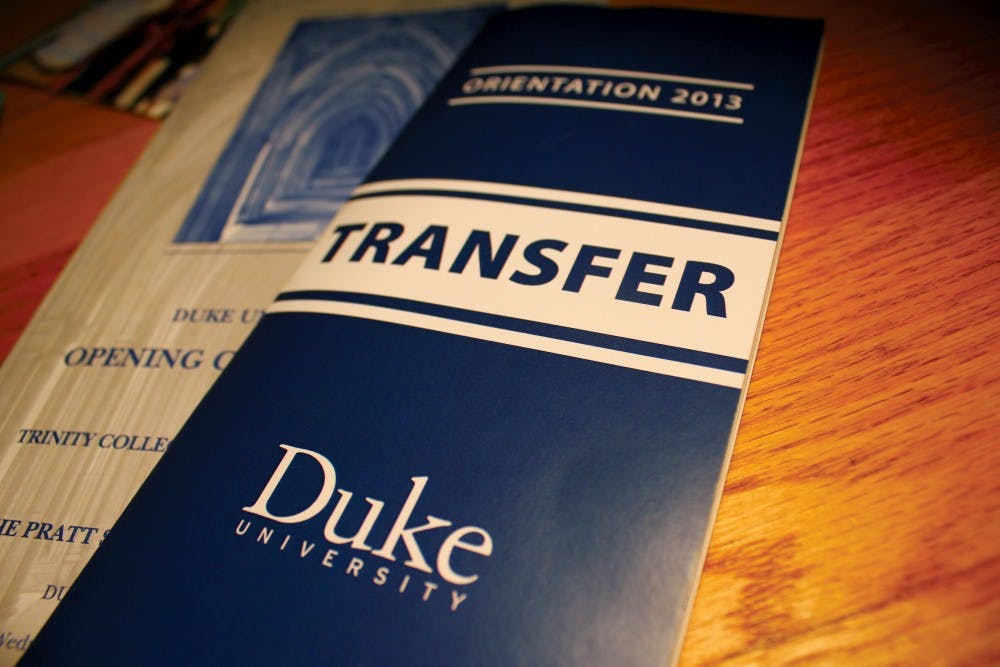Despite traditionally admitting low numbers of transfer students, Duke administrators are seeking to slowly increase the presence of transfer students among the student body.
For the 2013-14 academic year, admissions received 753 transfer applicants. Of those, 37 students were admitted and 23 enrolled in the Fall. In the past five years, the number of applicants per year has increased from an average of 500, Dean of Undergraduate Admissions Christoph Guttentag said. The majority of transfer students are sophomores, but every year there are some juniors.
“Duke has traditionally accepted very few transfers as compared to many of our peers,” said Steve Nowicki, dean and vice provost of undergraduate education. “In the last couple of years, we have begun rethinking that.”
Increasing Applications
Guttentag said that the admissions department is working to expand the transfer program.
“It’s hard to actively recruit transfer students the way you would a freshman, because once they are at a four-year college, you don’t want to encourage students to be dissatisfied in their current school,” Guttentag said.
Transfer students apply to the University for a number of reasons.
“While our social scene has quite the allure, my experiences with transfer students tell me that our academic offerings offer far more compelling reason for transferring to Duke,” Vice President for Student Affairs Larry Moneta said.
Guttentag added that the admissions team is working on making information for transfer students a larger part of the website and presenting more information about transferring at information sessions.
“Over time, the word will spread that we are expanding our transfer program,” Guttentag said. “But our admissions rate will always be discouraging.”
Guttentag said that the admissions team accounts for the possibility of transfer students as they plan the acceptances of first year students.
“[Transfer students] are not taking anyone’s place,” he said. “They are factored into our overall goal of 1,705 students per class.”
Nowicki added that the University will wait until the pool of transfer applicants is stronger before there is any noticeable increase in the number of students admitted. As only students of "Duke quality" can be admitted, it might take a few years.
“The trick is that because we don’t have a reputation for taking transfer students, we don’t get too many requests,” Nowicki said.
There is an intersection between an increased number of transfer students and an increase in the number of international students, Nowicki noted. Many students start out oversees and then decide that they would prefer to come to the United States.
He added that most students who transfer to the University are very academically successful.
“The majority of transfer students are students who might have thought about coming to Duke and decided to go somewhere else, but then determined that wasn’t the best fit for them,” Nowicki said.
He noted, however, that there have been successful transfer students who were denied to Duke on their initial application.
“Transfer students contribute widely to the undergrad experience,” Moneta said. “They offer perspective and experiences obtained from their other school and have generally thought long and hard about the distinctive reasons they prefer to be at Duke. They tend to be extremely motivated to catch up with their classmates and have clarity about their Duke and post-Duke goals.”
Guttentag echoed this sentiment.
“Whether they come from community college or MIT—and we have had transfer students from both—they always bring unique perspective,” Guttentag said.
Making the Transition
Moneta added that transfer students have a separate orientation each year—including a Transfer Advisory Counselor program that pairs new transfer students to older ones, similar to the First-Year Advisory Counselor program.
Senior Katherine Fraile, co-chair of the TAC program, transferred to Duke from the University of Pittsburgh as a sophomore. She called the transfer an all-around “amazing experience.”
“I count myself lucky to have been able to transfer here,” Fraile said. “While it presents its own challenges and opportunities, there's such a great community at Duke that transfers feel like a welcome part of the family from the second they step foot on campus.”
The TAC program—founded by former Dean of Arts and Sciences Bob Thompson—is much like the FAC program for first years and is intended to teach incoming transfer and visiting international students all about Duke, Fraile said. She added that it is important for transfer students to know there are others going through the same situation.
“It's a great opportunity for them to get to know other students who are going through the same experience now or have previously done so,” Fraile said. “Every year we have a small—but very impressive—group of students from universities all over the country and world.”
She added that each transfer brings their own unique perspective from other universities.
“I think, for that reason, transfer students are able to appreciate even more all that Duke has to offer and how great it is because they have real experience to which to compare it,” Fraile said.
Get The Chronicle straight to your inbox
Signup for our weekly newsletter. Cancel at any time.

